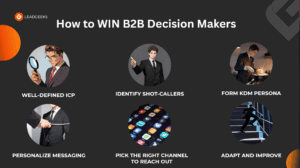Navigating the world of B2B sales to find and engage with business to business decision makers can sometimes feel a lot like setting a course through a complex maze. But it doesn’t have to be.
With a solid account mapping approach, you can smoothly chart a clear path straight to the heart of your prospect’s company (if you missed it, we also covered why Account Mapping is important in 2024 here!). In this blogpost, we will be covering how you can connect with them effectively.
Making Sure Ideal Customer Profile (ICP) is Defined
Before initiating account mapping, decide on the characteristics of your perfect customer. What size is their business? Which industries do they operate in? What are their market challenges?
Having these information ensures that you’re concentrating on high-potential targets.
Here’s what you can do:
Analyze Your Best Customers
Mine data from your top 20% of clients. Look for patterns in:
- Firmographics: Industry, company size, revenue, and geographic location.
- Behavioral Trends: Common pain points, buying cycles, and product usage.
- Technographics: Software stacks or tools they rely on (e.g., CRM, ERP).
Find Industry Insights
Use either data from within the company, online reports or niche platforms to identify underserved markets or emerging needs.
Identifying the Shot Callers
Now we are going into the meat of this post’s topic; account mapping the decision makers. A bullseye hit requires knowing exactly where to aim. Decision-makers aren’t always the CEO. In B2B, purchasing power is often distributed across roles like CFOs, IT directors, or department heads. Your goal? Map the hierarchy to pinpoint who holds the keys.
Finding out who calls the shot or decision makers require the right tools and method in order to do it effectively. Your goal here is to learn who these individuals are and what they care about.
Here’s what you can do:
Find the Decision Makers
-
Analyze Organizational Charts: Look into their organizational structures and key titles.
-
Track Engagement Signals: Look for stakeholders who:
-
Attend industry webinars.
-
Engage with competitor content.
-
Follow thought leaders in your niche.
-
-
Social Listening: Monitor LinkedIn groups, X threads, or Facebook communities where prospects discuss challenges.
Map Roles According to Influence
-
Decision-Makers: Final approvers (e.g., CFO, CIO).
-
Influencers: Advisors who shape decisions (e.g., IT managers, department heads).
-
Champions: Internal advocates who amplify your value (e.g., end-users or mid-level managers).
Making Decision-Maker Personas
Once you’ve got your decision-maker in view, it’s time to get personal. Develop a profile on them—their needs, their day-to-day challenges, and what solutions they’re likely hunting for.
Having this developed profile will greatly help you personalize your message to their pain points later on.
Here’s what you can do:
Conduct Stakeholder Interviews
If possible, talk to existing clients in similar roles. Ask:
- “What’s your top priority this quarter?”
- “What keeps you up at night?”
Analyze Digital Footprints
Review content they share, comment on, or post. For instance:
- A CFO sharing articles on cost-cutting? Highlight ROI in your pitch.
- A CTO engaging with AI trends? Position your product as innovation-driven.
Use Forums and Reviews
Sites like G2, Capterra, or industry-specific forums reveal unfiltered pain points.
Personalizing Your Messaging
Now, you’ve got to turn that understanding into a message that’ll make them stop and listen. Whether you’re sending an email or connecting on social media, keep it relevant and chock-full of how your solutions align with their goals.
Remember, you’re not just offering a product, you’re bringing them a game-changer that can meet their goals and offer tangible ROI.
Here’s what you can do:
Reference Specific Triggers
-
-
“I noticed your team recently expanded into Europe—our localization tools helped [Client X] cut onboarding time by 40%.”
-
“Congrats on the product launch! We specialize in scaling post-launch support for SaaS companies like yours.”
-
Align with Their Goals
If your persona highlights a focus on sustainability, emphasize eco-friendly features or CSR outcomes.
Use Multi-Channel Sequences
Combine LinkedIn messages with tailored emails and value-driven content (e.g., a case study PDF).
Choosing the Right Channel
Before reaching out, pick the best way to do so. An email, a direct message, or even a friendly phone call? Think about what suits them best.
It’s about quality touches, not just quantity.
Here’s what you can do:
- Try out different outreach timings, days, content and anything that affects the chances of your messages getting seen. This will help optimize future efforts.
- In any conversation that starts, try to always offer thoughtful additional value for them. This can be in the form of free resources like whitepapers or ebooks.
Specific Channel Strategies
-
Email: Ideal for data-driven pitches (ROI calculators, case studies).
-
LinkedIn: Perfect for thought leadership sharing or warm introductions via mutual connections.
-
Phone Calls: Use sparingly, but effectively—e.g., after they download a high-value resource.
-
Direct Mail: Surprise high-priority accounts with personalized swag or handwritten notes.
Keep Learning and Improving
Finally, what works today might not work tomorrow, and that’s okay. Review how well your strategies perform and refine them often.
The world of business to business decision makers is always evolving, and so should your techniques.
Here’s what you can do:
- Measure KPIs such as response rate, engagement levels and conversion rates often and regularly. Set up a specific day within a week if you have to!
- Always be willing to adapt and adjust your ICP and personas as your understanding of their needs deepens.
Deciding to step into the B2B realm is one thing – connecting with business to business decision makers is another ballgame entirely. But with account mapping, you’re not just reaching out blindly. You’re equipped with the insights, the personal touch, and the strategic acumen to turn prospects into partners.
Ready to turn prospects into partners after reading today’s post? Lets dive in even more with account mapping to make informed, strategic connections. Share your own experiences or leave a question on the comments below and lets discuss further!















Leave a Reply